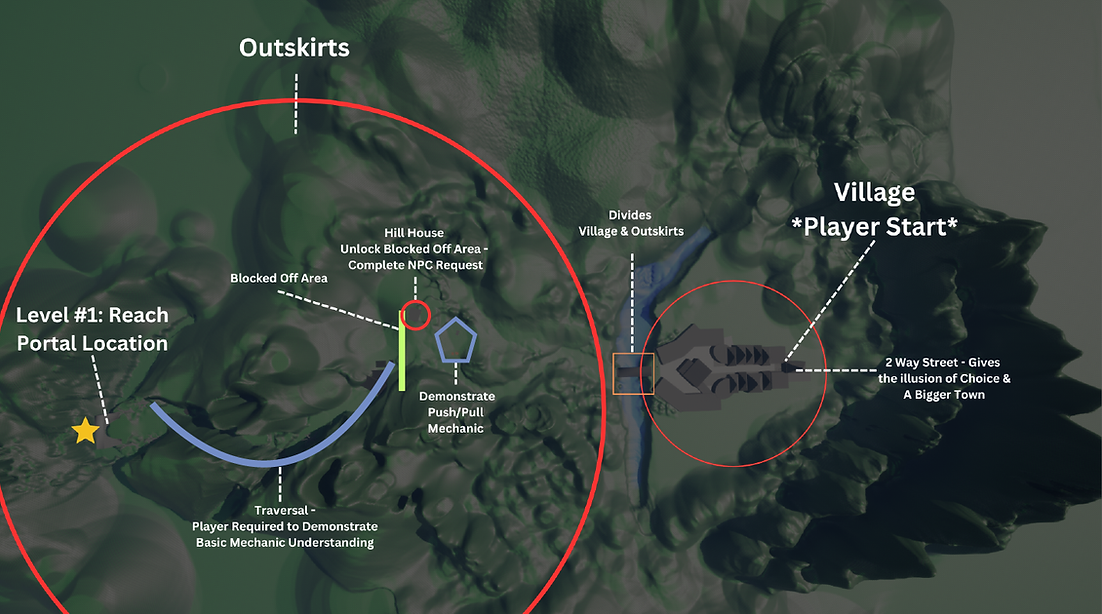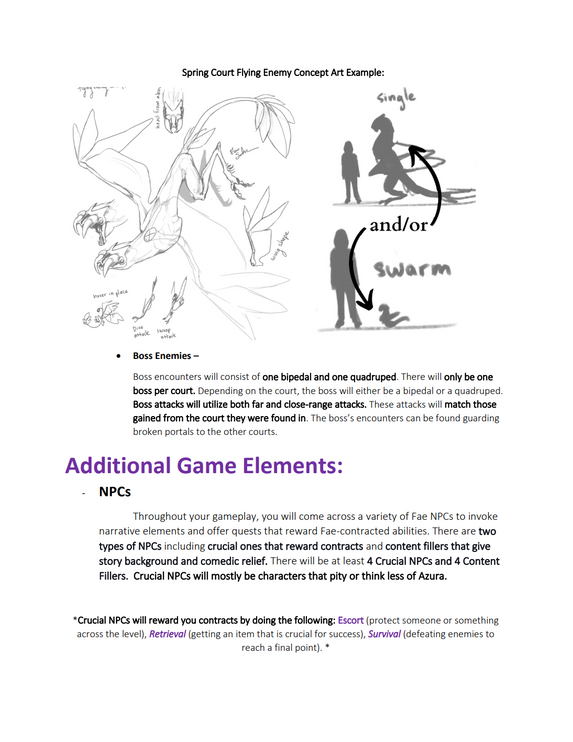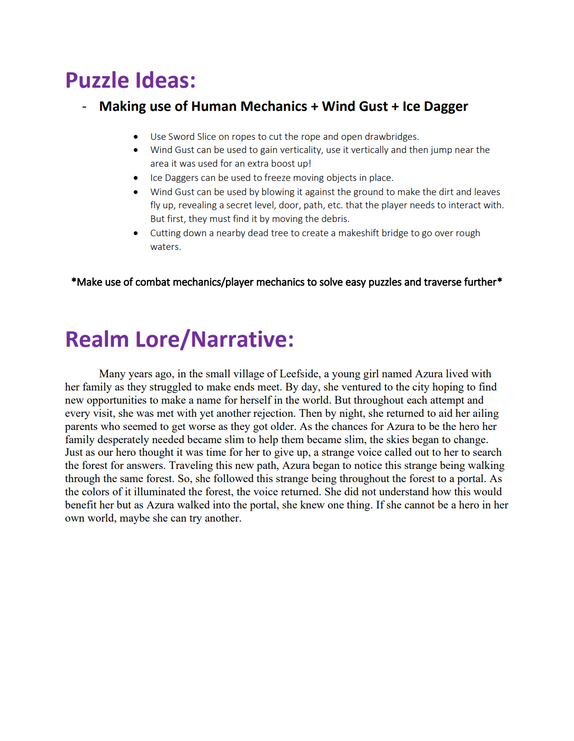Realm's End
Action-Adventure

Who will you become...A hero or another Corruption?
Realm’s End is an action-adventure game where you go on your own journey through the realms of the fae to defeat the evil Rogue King.
Along the way, you will collect magical contracts providing help on your quest in exchange for your protection. But beware, corruption has fallen upon the world and caused it to fall into chaos, making everywhere you go even more dangerous.
But through it all, it is up to you to travel to the Realm’s End to defeat the Rogue King and save the fae at all costs with the powers they provide for you. After all, this is your chance to be the hero you were always meant to be.
*This is the presentation I created to pitch my design ideas to the team.*
What have you done so far & are doing?
For this project, I contributed the following:
- Leading Design Team & Creative Direction for Realm's End
-
Providing visionary oversight & creative direction for Realm's End while managing a design team of 15 people across multiple discipline.
-
I run standups every 2 weeks, while checking in weekly on progress & to see if there are any issues that are stopping production that I can assist with.
-
Create documentation and run Hack & Plan for each 2-week sprint regarding goals. I come up with the goals for each sprint for my team and post the document prior to our call. During the call we go over the document and check in to make sure it is all doable and if they need anything to be successful or if there are any blockers.
- Game Design Documentation
-
I researched similar games to Realm's End including Jedi Survivor, Hogwarts Legacy, God of War, Spider-Man: Miles Morales, Hades, and more. Analyzed what worked for them in certain areas like narrative, combat, traversal, etc. to help establish our structure and gameplay for the type of game we want to build. I then extracted elements from my research to create a presentation regarding my ideas for the game to show the team and then iterated based on direction and feedback.
-
Created a game design document that is broken into 16 sections including the following: General Overview, Aesthetics, Theme, Design Pillars, Mechanics, Combat Overview, Seelie Abilities Earned, Unseelie Abilities Earned, Enemies, Additional Game Elements, Levels, Sublevels & Level Streaming, Puzzle Ideas, Realm Lore, Similar Art Style, and Similar Styled Games. This is a living document and is iterated on.
- 2D Illustrated Mockups & Level Vision
-
Created 2D mockups in illustrator for the Human Realm & the Spring Realm. This allowed me to present my ideas to the team but also hop into engine with an initial level design idea that displays the order and approximate length of key Gameplay Sequences such as NPC encounters, rewards, unlocked abilities etc.
-
I also created a mood board for the Human Realm and the Spring Court. This allowed me to show a sense of pacing in the levels and what could be expected. For instance, in the Spring Court mood board you can see the world visually getting more distressed as the photos continue. This will be replicated for the gameplay experience in engine.
- Designing & Implementing Levels in Engine
-
I am currently whiteboxing levels and learning all about Level Streaming & Sub Levels to ensure a better-quality experience for the big levels we are intending to build.
-
Utilizing & learning Landscape Mode & Modeling Mode in UE5. This has taught me how to sculpt terrain. Then I can arrange buildings, structures and objects on it to create a compelling environment and gameplay experience.
- Standardization & Metrics
-
As development continues creating standards and metrics become more important especially for objects that are repeatedly used or effect player movement. This way we can create a cohesive gamep[ay experience not just in my individual level but the game as a whole. This process has started with stairs. All the stairs in our game will be 30 cm height & depth.



Development Time:
June 2023 - Current
Mystic Moon Studios
Coming to Steam & Itch.io
Unreal Engine 5

Design Process
Up to Date Design Doc
~ Design Doc
This design documentation is an overview of all the details regarding our game Realm's End. This document was created by myself using collaborated ideas, narrative, and gameplay created by our team.
This document is broken into 16 sections including the following: General Overview, Aesthetics, Theme, Design Pillars, Mechanics, Combat Overview, Seelie Abilities Earned, Unseelie Abilities Earned, Enemies, Additional Game Elements, Levels, Sublevels & Level Streaming, Puzzle Ideas, Realm Lore, Similar Art Style, and Similar Styled Games.
*This is a living document and will receive updates frequently*
GYM PHASE
~ Gym (On Going)
I am currently testing & learning all about Sublevels & Level Streaming. Persistent levels will be used for our bigger areas such as the courts themselves (Human Realm, Spring Court, Summer Court, etc.). Then smaller sections will be dynamically loaded inside these levels such as enemies, lighting, side quests, and NPC encounters. These smaller sections would be loaded in if/when the player passes a certain volume (ie getting close to the said area).
Utilizing this ensures that not everything is running in the game simultaneously, ensuring a better FPS experience for an action-adventure game.
See Game Design Doc Sublevels & Level Streaming for more information
*We will utilize loading screens only after portal use, everything else will be loaded in seamlessly. (In-Between Persistent Levels)*
Mood Boards


BRAINSTORM LEVEL #1 IDEAS
~ Level #1 Human World Idea (ITERATION #1 - PEN TO "PAPER)
Player Goal: Reach the Spring Portal While Learning Mechanics
Design Intent: I plan to lead the Player to the Spring Portal by utilizing their environment, lighting, and NPC interactions. Throughout this journey, they will be introduced to their basic mechanics in engaging and fun ways.
Introduce Basic Mechanics:
-
Basic Movement - WASD
-
Sprint - Shift
-
Jump/Climb – Space Bar
-
Attack/Swing – Left Click (use Swing to Clear Dead Branches in the level)
-
Push/Pull – R (Use when it comes to Boulders)
-
Interact – E (Will be interacting with Sword)
Level Breakdown -
-
The player comes out of their house, at the head of the town in the early morning looking for a job.
-
Comes across NPC, they don't have a job for Azura but mention the old bat that lives on the hill is always looking for people to chop him some firewood from the woods. *Player knows to find an old man that lives on the Hill*
-
The player traverses through the town, it is not lively due to it being early. Will use leading lines in the buildings and lighting in the lampposts to guide players to the end of the town. There will be more than one way to get there to give the illusion of the town being bigger as well as giving player choice.
-
The town feels crowded and lived in even though nobody is quite up yet.
-
The player takes a bridge to get to the outskirts, upon this they will see a leaving town sign. This will queue the event of the lamppost flickering and going out. This bridge will be the divide between the mood of the village and the outskirts.
-
Wide Open Fields contrast the narrow inviting crowded town that the player came from. This will be intended for the player to feel vulnerable.
-
The player sees light and a house on the hill, then comes across an old man.
-
The old man tells her he doesn't have a job for her, but if she can clear these boulders out of the road so his food cart can pass and get to the town, he will tell her a secret that could lead to a fortune.
-
The player is introduced to the push/pull mechanic by moving these objects out of the way for the old man.
-
After completing this task, he mentions a sword relic that could be worth a lot of money that he's seen in the woods but is too weak to retrieve himself.
-
The player heads to the woods opening and sees another light post flickering and it goes out, however, they see a glimmer of something shiny inside the woods.
-
A sword can be found stuck in a boulder. Moonlight glimmers the sword and lighting bugs seem to be attracted to the area.
-
The player interacts with the sword - cue event of the player pulling out the sword and gaining the swing mechanic. The entrance magically disappears after the player attains the sword.
-
The player sees no way forward, but lighting bugs surround some dead vines that look like a way forward. This will introduce the swing mechanic, cutting the vines away and opening a pathway.
-
Lightning bugs will be used to call attention to certain areas.
-
Traversal Area will ensure the player can demonstrate all the basic mechanics.
-
The player will come across a big body of running water, players must use the swing mechanic on a dead tree to create a bridge towards a rock. Players will use the environment to traverse the running river.
-
The player will then come across a puzzle section. This puzzle section will have the player use push/pull on three boulders. Two will be visible, one will be hidden. Players must create makeshift stairs to get to the higher platform.
-
From there, we will have a short traversal space until reaching the spring portal. The player will hear distress noises coming from the portal.
Inspirations:
-
Sword in the Stone
-
Hogwarts Legacy use of Spiderwebs
-
Missouri Woods (Lightning bugs gravitating towards certain areas)


Scratched Idea
*Find out why below in Landscaping + Sense of Space*
Whiteboxing

.png)

~ Village Intention/Context (DESIGN CHOICES)
After creating 2D mock-ups for this level, I hopped into UE and started whiteboxing the village for Level 1. The player begins their journey at the head of the village with Azura on a mission to find work to help support her family. To work with this story, I wanted to ensure the NPC encounters would be those Azura is seeking out for work. One NPC can be found in the village and very early on. The village NPC will tell the player that they aren't hiring, but they know the old crazy man on the hill is always looking for young blood. This will indicate to the player where their next NPC & Objective will be located.
I designed this village with the intent of having it feel bigger than it was. One way I did this was by creating smaller store buildings so that they could increase in number. This way I could have many stores filling the space instead of a few larger stores. I also have more than one path that the player can take on their way to find the man that lives on the hill. This in turn gives the illusion of player choice & the town being bigger. I also designed the space to be tighter ie (having the buildings closer together to the ones across from them). This gave a feeling of being crowded, but still open enough for easy movement. This choice also reflected a similar look to the towns I picked out for my mood board when brainstorming for the level.
~ Above Images are NOT the first Iteration
At first glance, the above image could look like the first iteration, however many things were changed to get it to this point. For example, the design originally had multiple pathways as seen in the 2D visual document. However, after building it out in UE I realized that it wasn't needed and could be viewed as confusing. I originally wanted multiple pathways to make the town feel bigger, but I realized I could do that in other ways (see above paragraph). Yes, I could combat the confusion with specific landmarks, etc. However, the player's objective is to essentially leave the town and find the old man making this unnecessary.
Another change was the angle of the building that is placed in the center near the end of the town. After playtesting it myself I knew that the player could come to that edge and see the opening of the other pathway and traverse backwards. As this is not the intended goal, I moved it around until I was able to cut that slight line completely to increase the chances that they would not traverse back to the start of the town.
Additionally, other changes were made such as the length of the first part of the town, how many arches there would be, how many stores, the size of the pathway between the buildings, and how big/tall the center building would be. All of these changes came from me hoping in engine and playtesting to get an idea of how the space would feel for the players and if it was what I intended.
Landscaping + Sense of Space




~ Landscape Mode + Modeling Mode
After I was happy with the metrics and setup of the village, I started building out the terrain utilizing Landscape Mode. (I got really into this). I decided to change my original idea of the second half of the level starting at the wood entrance and shifting to a mountain entrance instead. This was changed because I wanted a stark contrast between the human world and the spring court. As the spring court is heavily forested making this change would allow the spring court to stand out even more. This area will still require the player to learn basic movement mechanics such as jump, climb, push/pull, and sprint but not slice. I decided against introducing slice in Level 1, but instead, reward the sword at the end of Level 1 and introduce slice for both combat & puzzles in Level 2. This way the player can focus on those basic mechanics and be introduced to the story with a nice reward at the end. While the other ideas I came up with in that mock-up could be used in Level 2.
I also utilized modeling mode to create bizarre shapes such as the buildings in the town. This allowed for fast-paced iterations!
Iterating Further - Human World Map Layout

~ Above is my latest map of the human world. You can view where each event will occur above. The only thing unmentioned is the first NPC Encounter in the village. One thing to note is the divide between the outskirts and the village. I intend for the village to feel peaceful and calm while the outskirts feel more deserted, lonely, and daunting. Unlikely the closeness in the town the outskirts will be more open to the elements and the player's environment.
A Look Inside


.png)












